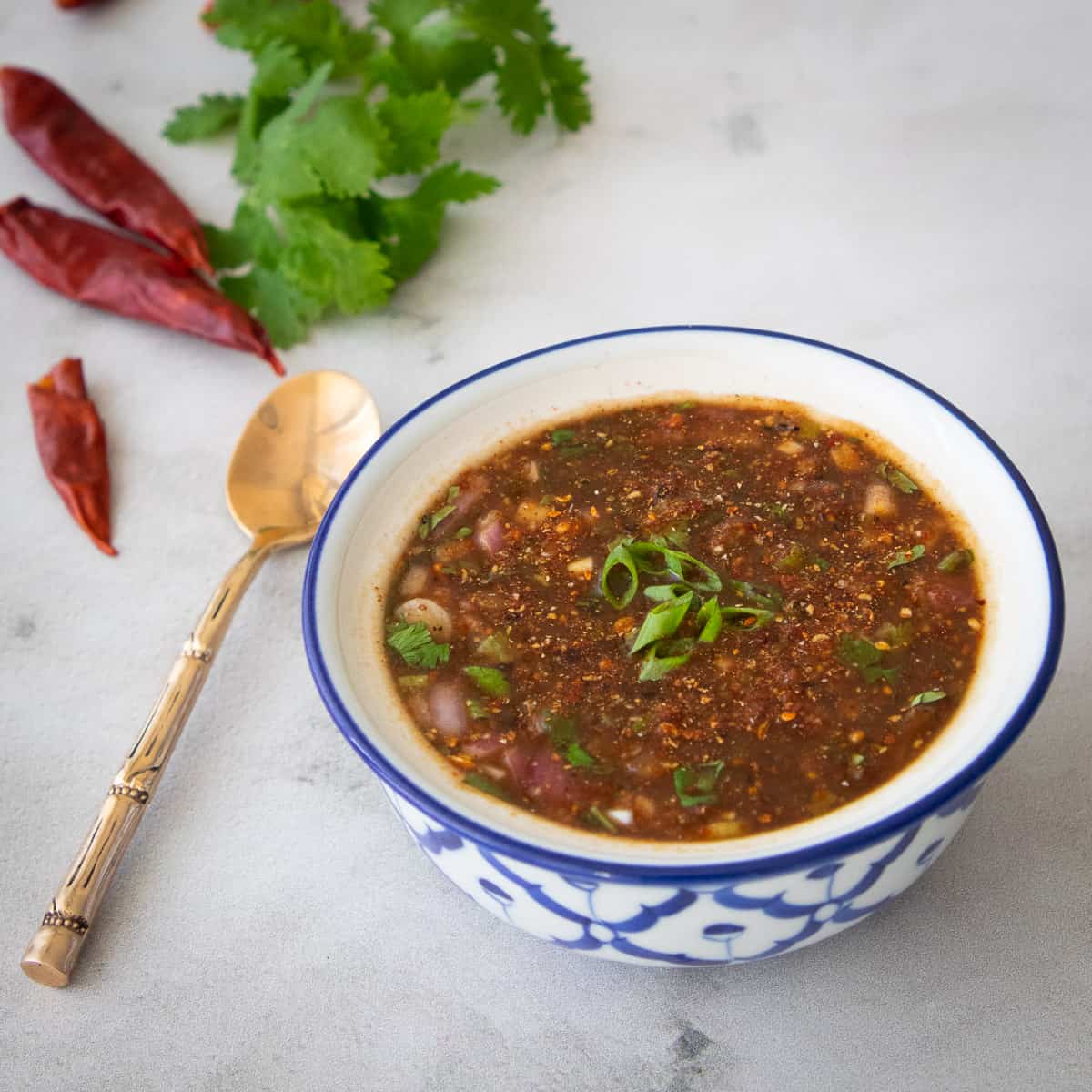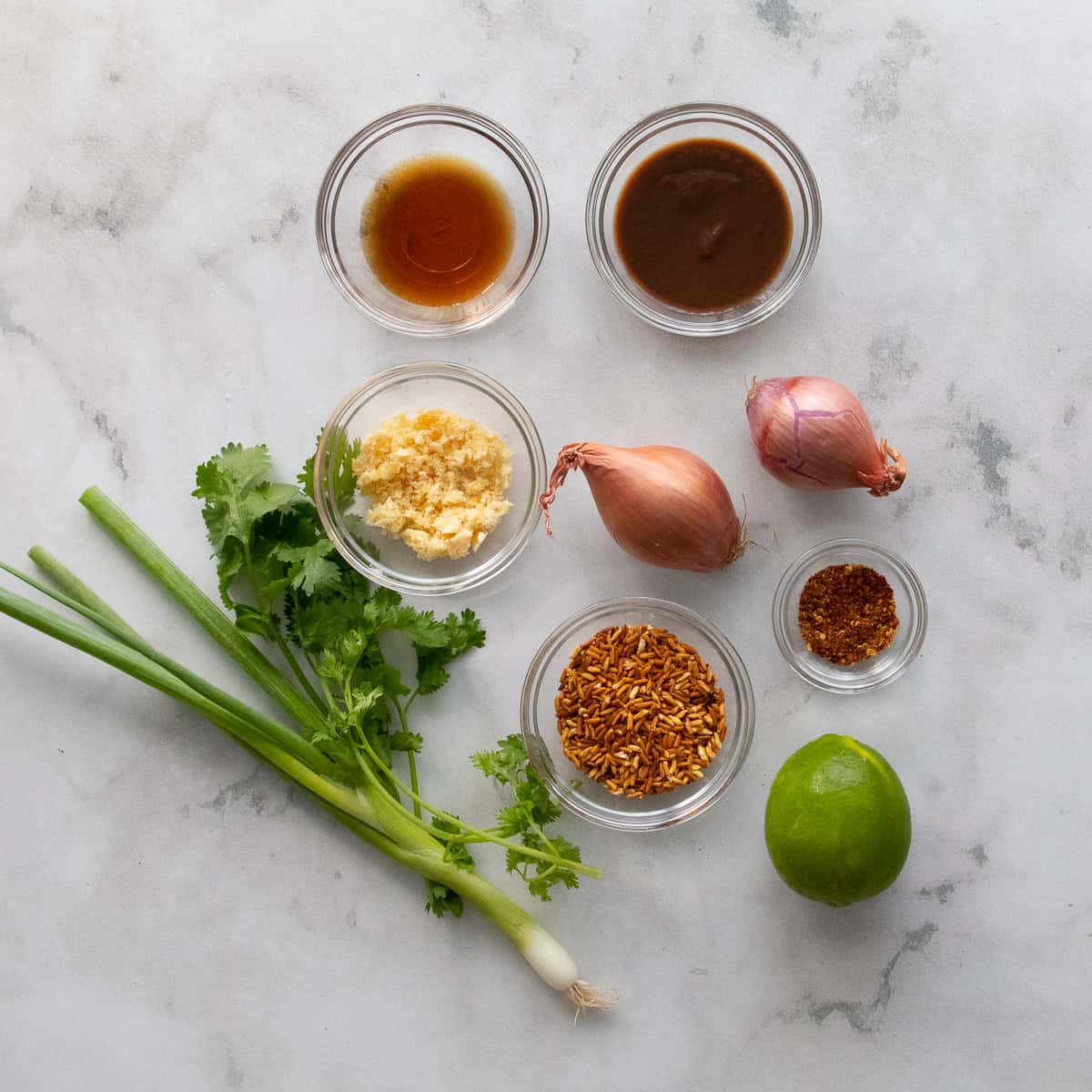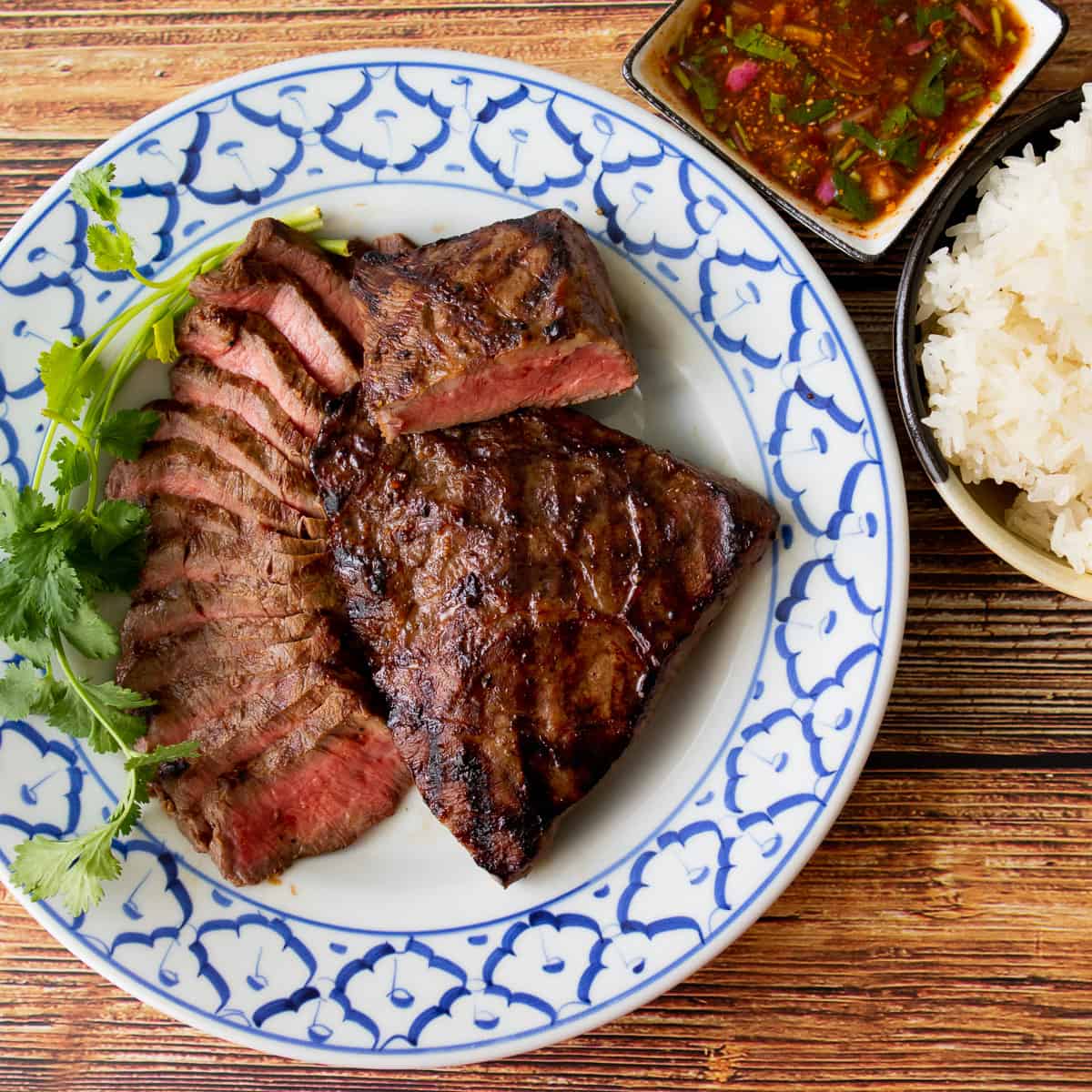Give Thai people a piece of meat and we're going to ask, "Where's the nam jim jaew?" Nam jim jaew is Thai people's #1 go-to sauce for all kinds of meats, especially grilled meats. A must-have for any Thai barbecue, but it's also amazing on steaks, roast chicken, or pork chops. It's also easy to make and can be made in advance!

Jump to:
What is Nam Jim Jaew?
Nam jim jaew is the classic Thai dipping sauce for all manner of meats, especially grilled meats. It's made from fish sauce, lime juice and/or tamarind, sugar, dried chilies, toasted rice powder and fresh herbs. The spicy acidity, with toasted rice aroma and fresh herbs, makes it the perfect thing to enhance and balance the richness of meats.
Nam jim means dipping sauce and jaew also means dipping sauce, but in the Northeastern Thai dialect! This is because the sauce originated in Northeastern Thailand, but it quickly spread to the rest of the country due to its ease, versatility, and deliciousness. So nam jim jaew essentially means "the dipping sauce from the Northeast"!
Ingredients and Notes
Here are all the ingredients and important notes about them. For amounts, see the recipe card below.

- Fish sauce. See my post here on how to choosing good fish sauce
- Tamarind. Store bought tamarind paste (aka tamarind concentrate) is fine, just be sure to buy one from Thailand. If you want to make your own from pulp it is easy! Follow my guide to making homemade tamarind.
- Lime juice.
- Palm sugar or light brown sugar. White sugar works too. Read all about palm sugar here!
- Roasted chili flakes. You can buy store bought chili flakes and toast in a dry pan briefly until smokey, or toast whole chilies (arbol is a good choice) and then grind. The toasting is optional, but adds a nice smokiness.
- Shallots.
- Toasted rice powder. This is absolutely key to this recipe! Adds an iconic toasty aroma that makes all the difference. It's made simply by toasting raw rice (pictured) in a dry skillet and then grinding it. Here's a detailed dedicated post on toasted rice powder if you want to learn more.
- Fresh herbs, commonly we use green onion and cilantro, though mint, sawtooth coriander or even dill can be used.
Step-By-Step
Here's a bird's eye view of the process, for amounts and detailed instructions, see the recipe card below!

- If making toasted chili flakes from whole chilies, toast them in a dry skillet over medium high heat for a few minutes, stirring constantly, until some charred spots form on the chilies. You can also toast store bought chili flakes in this way.
- Grind the chilies in a coffee grinder or spice grinder.
- Make the toasted rice powder by toasting the rice in a dry pan over high heat, stirring constantly, until dark brown.
- Grind into a powder using a coffee grinder or mortar and pestle.

- Combine the fish sauce, tamarind, lime juice, and palm sugar or white sugar.
- Stir until most of the sugar is dissolved. Any stubborn chunks of palm sugar should dissolve in 5 minutes or so as it sits in the liquid.
- Add the shallots, toasted rice powder, chilies, and fresh herbs.
- It's now ready to use!
3 Useful Variations of Nam Jim Jaew
Nam jim jaew is not a fixed recipe, it's more of a concept. So depending on what is being served, people will change the ratios of ingredients to better pair with the food. Nam jim jaew from 2 restaurants will rarely be the same!
In the recipe card, I give you 3 different versions:
- "Original" All-Purpose Jaew. When in doubt, this is the one to make. A good balance of salty, sour, and sweet that will go with most thing; especially BBQ chicken, steak, and pork jowl. It has a bit of a thicker body so it will cling well to meats when dipped.
- Light Jaew. Made to be lighter in body with more lime juice, it will cling lightly to meats when dipped, making it perfect for thin, delicate pieces of meat such as in hot pot. It is also less sweet and more tart and salty, which helps it cut the grease of very fatty meat such as pork belly, or meat that is already quite sweet.
- Mellower Tomato Jaew. The original jaew is very intense, making it easy for those unfamiliar to overdo it. So I came up with a mellower version with the addition of diced tomatoes that people can more generously spoon onto their meat.
Save this recipe!
What to Serve with Nam Jim Jaew

Some classic dishes that are always served with nam jim jaew are:
- Thai BBQ chicken (gai yang). This is a staple in my house, and you can bake the chicken instead as well.
- Grilled steaks. We love it so much that even some Western steak houses will offer nam jim jaew alongside gravy because some Thai people (me included) just cannot have meat without it!
- Grilled pork jowl.
- Northeastern Thai hot pot (aka jim jum or jaew hon). Since the pieces are delicate, we use the lighter jaew for this one.
- Crispy pork belly, I especially love it with crispy pork belly because the jaew cuts the fat so well that you'll be able to enjoy it without it feeling overly greasy. I also recommend the light version for this.
But really, any meat, Thai or not, can benefit from nam jim jaew. Try it on roast beef, roast chicken, or even some firm-flesh fatty fish such as salmon, trout, or mackerel.
Storage and Advance Prep
Storage: You can keep leftover nam jim jaew in the fridge for up to a week. The herbs will look wilted, of course, and the sauce will thicken slightly because the rice will have absorbed some liquid, but it will still taste fine. So ideally, you don't want to make more than you need. But you can....
Make the "base" in bulk! If you want quick and easy access to nam jim jaew you can absolutely make a bunch of the "base" ahead of time and keep it in the fridge. You simply need to omit a couple of things:
- Leave out the leafy herbs and add when serving. Otherwise the herbs will look dodgy within a day. If you're lazy you can definitely serve the sauce without the herbs at all.
- Leave out the toasted rice powder and add when serving. You can toast the rice ahead of time and keep it whole in a jar. When ready to serve, grind it up and add to the sauce. The aroma of toasted rice is fleeting so you don't want to add it far ahead of time.

Thai Dipping Sauce for Meat (Nam Jim Jaew)
Equipment
- mortar and pestle or coffee grinder
Save this recipe!
Ingredients
"Original" All-Purpose Nam Jim Jaew
- 1 tablespoon jasmine rice or glutinous rice, uncooked
- 2 tablespoon tamarind paste, (see note 1)
- 1 tablespoon fish sauce
- 1 tablespoon lime juice
- 1 tablespoon palm sugar, finely chopped, packed
- 2 tablespoon finely diced shallots
- 1 teaspoon toasted chili flakes, or to taste (see note 2)
- 3 tablespoon chopped herbs such as cilantro, green onions, mint, or sawtooth coriander
Light Nam Jim Jaew (see note 3)
- 1 tablespoon jasmine rice or glutinous rice, uncooked
- 2 tablespoon fish sauce
- 1 ½ tablespoon lime juice
- 1 tablespoon tamarind paste, or sub another ½ tablespoon lime (see note 1)
- 1 teaspoon sugar
- 1 teaspoon toasted chili flakes, or to taste (see note 2)
- 2 tablespoon minced shallots
- 3 tablespoon chopped herbs such as cilantro, green onions, mint, or sawtooth coriander
Mellower Tomato Jaew (see note 3)
- 1 recipe All-Purpose Nam Jim Jaew, from above
- ⅓ cup small diced juicy tomatoes
Notes
- Use tamarind paste from Thailand which comes in plastic tubs or glass jars. Sometimes they're labelled "tamarind concentrate." Do not use tamarind paste from India for this.
- Toasting the chili flakes are optional but adds a nice smokiness. You can buy store bought chili flakes and toast them in a dry skillet on medium heat for a few minutes until they darken and smell smokey. Or buy whole dried chilies, toast them in a dry skillet until charred spots form, then grind in a coffee grinder. (Arbol chilies are a good "medium heat" option.)
- Light jaew is what I prefer for delicate meats (hot pot) or very fatty meats (pork belly). Mellower tomato jaew is less intense and allows you to use it as a "spoon-over" sauce, as opposed to a dipping sauce, without it becoming overpowering. More info on these variations in the blog post!
FULL VIDEO TUTORIAL
All my recipes come with step-by-step video tutorials with extra tips not mentioned in the blog post, so make sure you watch the video to ensure success. If you enjoy them, consider subscribing to the YouTube Channel to not miss an episode. Thank you!
Subscribe to my YouTube ChannelInstructions
For All-Purpose and Light Nam Jim Jaew
- Make the toasted rice powder by adding the raw rice into a small dry skillet over medium high heat. Stir constantly until the grains are dark brown (it may get a bit smokey). Remove from the pan immediately to stop the toasting, and grind into a powder using a mortar and pestle or coffee grinder.1 tablespoon jasmine rice or glutinous rice
- In a small bowl, combine the tamarind paste, fish sauce, lime juice and sugar; stir until the sugar is mostly dissolved. *If using chopped palm sugar, any stubborn chunks that won't dissolve after a good stirring should dissolve in 5 minutes or so as they sit in the liquid. So no need to worry about them unless you're serving it immediately; in which case you can warm it up in the microwave briefly (5-8 seconds) to help the final bits of sugar dissolve. Smashing the chunks with a spoon will also help.2 tablespoon tamarind paste, 1 tablespoon fish sauce, 1 tablespoon lime juice, 1 tablespoon palm sugar
- Add the shallots and chili flakes and stir to mix.2 tablespoon finely diced shallots, 1 teaspoon toasted chili flakes
- Close to serving time, add the toasted rice powder and all of the fresh herbs; stir to mix.1 tablespoon jasmine rice or glutinous rice, 3 tablespoon chopped herbs such as cilantro, green onions, mint, or sawtooth coriander
For the Mellow Tomato Jaew
- Make the all-purpose jaew as per instructions above, and stir in the diced tomatoes along with the fresh herbs. If you can, let it sit for a few minutes before serving to allow flavours to mingle.⅓ cup small diced juicy tomatoes






Kristin says
I made this to go with a roasted leg of lamb for thanksgiving and oh my goodness it was perfect with the fatty meat. Refreshing herbaceousness from cilantro and perfect balance of sour, and salty, literally showstopping. Toasting the rice is the hardest part and honestly not difficult. 10/10! I’ll be having this on steak or salmon next.
WILLIAM G MCEWEN says
Ok, you filled in the blanks of everything I was doing wrong or missing... Crispy pork belly was the primary reason for the dip. Your dip was much better, but I thought is was missing 2 items; garlic and Thai chilies. In addition, I added more sugar than what you called for. I added those ingredient and got exactly what I was looking for. Did I create a mortal sin?
I would really like to hear back from you because I love what you are doing.
Simon says
Great video. I love this sauce with weeping tiger steak which I have with sticky rice and a little salad of cucumber and tomato. But, I like to save some of the toasted rice (it keeps forever) and add it to dishes for the taste and texture contrast.
Ivan Clayderman says
Hi, thanks for providing us with this wonderful sauce recipe. I bought Ground Roasted Rice (Khao Khua). Would that work by substituting the jasmine rice or glutinous rice? I just use that and toasted with the mortar and pestle?
Thank you for your time
Maria says
Awesome dipping sauce! The recipe and tips are perfect!
Wendy Burns says
How long can I keep this in the fridge after making please
Pailin Chongchitnant says
Storage info is provided in the blog post above the recipe 🙂
Philippa says
OMG this is soooo good!
Erika Turk says
Our store was sold out of tamarind paste but we used the extra lime juice as suggested and made the light version — I could drink this stuff! It is so fantastic. Thank you for a great recipe!
David Brach says
I added a bit too much peppers the first time I made it...the extra spicy Jaew was an instant hit with my wife's Vietnamese family...so now I just make it extra spicy. I absolutely love the thinned out hotpot version. Thank you, Pai...I've earned some asian creds thanks to you.
Pailin Chongchitnant says
Hahaha that's awesome!!
Ju says
I've made this a couple of times, and I've always made more, much much more than I'm going to consume for that day 😁😁😁
It freezes 🥶 🥶 ❄️❄️ very very well -- for months, without the taste deteriorated.
Sustar says
I love all your recipes. My trusted Thai cooking guru.
I have a question that’s not related to this recipe. But I failed to recreat the soup they serve with Kao mok gai in Thailand. Could you please teach us? I used to have this amazing khao mok at nonthaburi called สยามข้าวหมกไก่ sometimes I dream about just the soup.
Pailin Chongchitnant says
I don't know what soup exactly they serve, as there isn't a standard one. Maybe it's just seasoned chicken broth, but potentially it could be a version of oxtail soup but maybe with a different beef cut? (recipe on the site)
George Donner says
This is a delicious sauce, and kind of fun to make. We had it with a store bought rotisserie chicken, and it was sensational.
Rick Hazle says
I love traveling in Isaan. It is a very interesting area of Thailand with a unique culture. Plus, the food is wonderful. This dip or sauce is great on plainly cooked/grilled meat and lightly steamed or fresh vegetables. I have even been known to dip some sticky rice into it as a quick snack. The ground, toasted rice is almost the best part. Thanks for the great recipe.
Keith says
This seems very similar to the seasoning sauce we mix up for Larb (Gai) and also close to a Nam Sod, both of which we love and are super quick to make. What are the key differences between this sauce and the ones used for those dishes? Are they all related somehow?